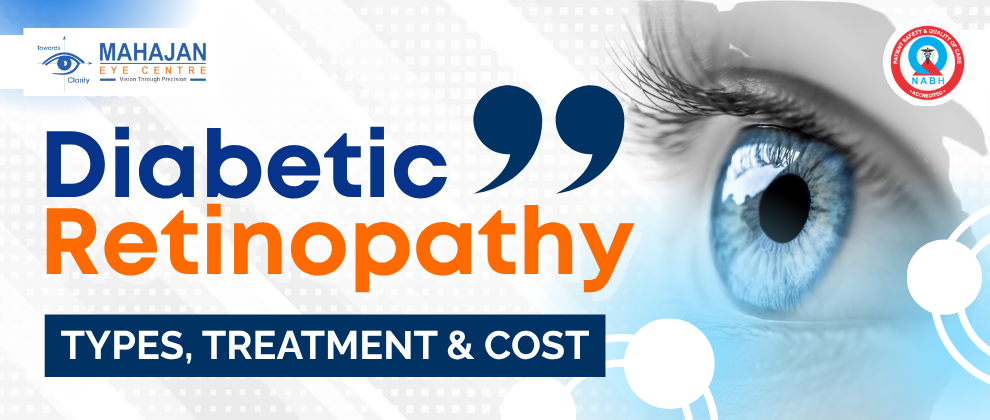
Diabetic Retinopathy: Symptoms, Types & Treatment Cost
Diabetic Retinopathy is one of the most common and serious complications of diabetes that affects the eyes. High blood sugar levels can damage the tiny blood vessels of the retina (the light-sensitive layer at the back of the eye), leading to vision problems and even blindness if not treated on time.
The good news: With regular eye check-ups and timely treatment, most patients can save their vision.
What is Diabetic Retinopathy?
In diabetes, the small blood vessels in the retina can become weak, leak fluid, or get blocked. Over time, this damages the retina and reduces vision.
Anyone with Type 1 or Type 2 diabetes is at risk, especially if blood sugar, blood pressure, and cholesterol are not well controlled.
Types of Diabetic Retinopathy: NPDR vs PDR
1. Non-Proliferative Diabetic Retinopathy (NPDR)
- Early stage of the disease
- Small leaks from retinal vessels cause swelling (edema) or small bleeding spots (microaneurysms)
- Often no symptoms in early stages
- May cause blurring of vision if swelling affects the central retina (macula)
2. Proliferative Diabetic Retinopathy (PDR)
- Advanced stage
- New abnormal blood vessels grow on the retina due to poor blood supply
- These fragile vessels can bleed inside the eye (vitreous hemorrhage) or cause retinal detachment
- Major cause of severe vision loss and blindness.
3. Symptoms to Watch Out For
- Blurred or fluctuating vision
- Dark spots or floaters
- Difficulty reading or seeing at night
- Sudden vision loss (in advanced cases)
Many patients have no symptoms in early stages, which is why annual eye check-ups are essential.
4. Diabetic Retinopathy Eye Tests & Screening Options
- Dilated Fundus Examination (DFE): Retina examined under special lenses
- Fundus Photography: Pictures of retina for documentation
- OCT (Optical Coherence Tomography): Scans for swelling in the macula
- FFA (Fundus Fluorescein Angiography): Dye test to check leakage and blood flow
Treatment Options for Diabetic Retinopathy
Treatment depends on the stage and severity:
1. Strict Diabetes Control
Controlling blood sugar, BP, and cholesterol is the foundation of treatment.
2. Laser Treatment for Diabetic Retinopathy
Used to seal leaking vessels or stop growth of abnormal new vessels. Reduces risk of severe vision loss.
3. Anti-VEGF Injections / Steroid Injections
Medicines injected into the eye to reduce swelling and stop abnormal vessel growth. Usually need multiple sessions.
3. Range of Services
The hospital should offer a comprehensive range of services, including
- Routine eye exams and prescriptions.
- Advanced surgical procedures like LASIK, cataract, and retinal surgery.
- Pediatric eye care, emergency services, and specialized treatments.
At Mahajan Eye Centre, services cater to all age groups and cover everything from diagnostics to advanced surgical interventions.
4. Vitrectomy Surgery for Advanced Diabetic Retinopathy
For advanced cases with vitreous hemorrhage or retinal detachment. Removes blood and scar tissue to restore vision.
Prognosis (Outcome)
- Early detection = Good outcome.
- If detected in NPDR stage, vision can often be preserved.
- In advanced PDR, treatment can save vision but recovery is limited.
- Lifelong follow-up is necessary.
Need for Regular Eye Check-ups
- All diabetic patients should have a comprehensive eye exam at least once a year
- If retinopathy is detected, check-ups may be needed every 3–6 months
- Regular OCT and fundus photography help track disease progression
Cost of Diabetic Retinopathy Treatment in India
- Eye check-up & basic tests: ₹500 – ₹2,000
- OCT / FFA scans: ₹2,000 – ₹5,000
- Laser treatment: ₹8,000 – ₹20,000 per sitting
- Intraocular injections (Anti-VEGF): ₹15,000 – ₹30,000 per injection (varies by brand)
- Vitrectomy surgery: ₹50,000 – ₹1,20,000 depending on complexity
Many insurance policies now cover diabetic retinopathy treatments. EMI and cashless options are also available at several eye centres.
Key Takeaway
Diabetic Retinopathy is preventable and treatable, but only if detected early.
- Control your diabetes
- Get regular eye tests
- Follow your doctor’s treatment plan
Don’t wait for symptoms — make eye check-ups a routine part of your diabetes care.


